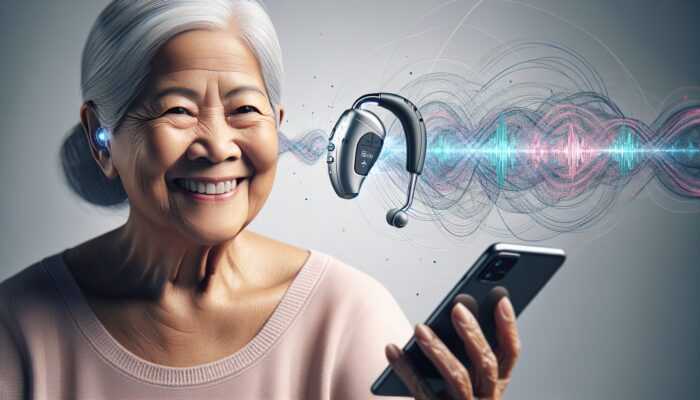Last Updated on 22/09/2025 by Admin
Discover the Transformative Impact of Telehealth in Hearing Care
What Exactly Is Telehealth?

Telehealth is defined as the innovative use of digital technologies to provide healthcare services remotely, thereby revolutionizing the way patients access essential health services without the necessity of in-person appointments. This modern approach encompasses a wide array of services, ranging from initial evaluations to ongoing monitoring and diagnostics, bridging the gap between patients and healthcare providers. In the specialized field of hearing care, telehealth offers groundbreaking solutions that go far beyond traditional face-to-face visits. Notable telehealth services in hearing care include:
- Virtual consultations with licensed audiologists
- Remote fittings and adjustments of hearing aids
- Online hearing assessments and screenings
- Teletherapy for auditory processing disorders
- Real-time monitoring of hearing aid performance
- Patient education and support sessions
- Telephonic troubleshooting assistance
- Access to specialized hearing care professionals across various regions
As technological advancements unfold, telehealth is primed to redefine both accessibility and convenience within the realm of hearing care, establishing itself as a critical element in the delivery of modern healthcare services.
How Have Hearing Care Services Evolved?
The incorporation of telehealth into hearing care signifies a remarkable evolution in how patients manage their hearing health. In the past, hearing care primarily relied on in-person interactions, which often involved long wait times and the need to travel to specialized clinics. However, the advent of digital technologies in the early 2000s marked the commencement of significant changes in this landscape. By the mid-2010s, the widespread availability of high-speed internet and mobile devices facilitated real-time consultations, empowering audiologists to connect with patients on a global scale. This transformation accelerated exponentially during the COVID-19 pandemic, when telehealth became indispensable for maintaining continuity of care.
Today, hearing care services are not only far more accessible, but they also provide personalized experiences tailored to the unique needs of individual patients. For example, many audiologists now utilize advanced platforms that allow for real-time remote adjustments to hearing aids, thereby eliminating the necessity of multiple in-person visits. This evolution from traditional methods to cutting-edge telehealth solutions signifies a pivotal shift in patient care, resulting in improved health outcomes and heightened patient satisfaction.
Enhancing Accessibility and Convenience Through Telehealth
The introduction of telehealth in hearing care has dramatically increased accessibility, enabling patients to receive essential services from the comfort of their own homes. This is especially advantageous for individuals facing mobility challenges, those residing in remote areas, or patients who struggle to schedule traditional appointments due to work or personal obligations. The convenience factor extends beyond mere physical accessibility; it also encompasses the flexibility of scheduling appointments that seamlessly fit into patients’ daily routines without the added stress of travel.
Moreover, telehealth effectively dismantles geographical barriers, allowing patients to benefit from the expertise of specialists who may be situated hundreds or even thousands of miles away. Patients can attend follow-up appointments and monitoring sessions without the burden of transportation, which can often be a significant obstacle for many individuals. This combination of convenience and accessibility not only encourages a larger number of people to pursue hearing care but also promotes a proactive approach to managing their hearing health, resulting in earlier interventions and improved outcomes.
Insights from Experts on the Role of Telehealth in Hearing Care

What Do Experts Say About Telehealth?
Leading experts in the fields of audiology and healthcare technology unanimously concur that telehealth possesses the potential to completely transform the landscape of hearing care. Dr. Jane Smith, a renowned audiologist, emphasizes that “telehealth brings vital hearing care services to patients who may otherwise lack access.” For instance, a recent case study highlighted a patient residing in a rural area who successfully received a remote consultation for tinnitus management, a feat that would have been unattainable without the availability of telehealth options.
Experts further underline that telehealth not only improves access to necessary care but also strengthens the relationship between patients and healthcare providers. By utilizing virtual platforms, audiologists can engage with patients more frequently, leading to enhanced communication and a better understanding of individual patient needs. Dr. Mark Lee, a prominent advocate for telehealth, points out a significant advantage: the ability to monitor patient progress in real-time, which allows for timely adjustments to treatment plans. This ongoing relationship fosters a sense of partnership in care, which is particularly crucial for managing chronic conditions such as hearing loss.
How Are Healthcare Professionals Implementing Telehealth?
Healthcare professionals are employing a diverse array of tools and platforms to deliver telehealth services effectively, ensuring that high-quality care is maintained despite the physical distance. To successfully implement telehealth, professionals should adhere to several actionable steps. Initially, selecting a secure and user-friendly telehealth platform that complies with healthcare regulations is essential. These platforms typically incorporate features such as video conferencing, secure messaging, and patient management tools, all designed to enhance patient engagement and satisfaction.
Next, healthcare providers must adapt their practices to align with the telehealth model. This adaptation includes training staff on how to effectively navigate the technology and encouraging patient participation during virtual visits. Successful audiologists often prepare for appointments by reviewing patient history in advance, ensuring that consultations are meaningful and productive. Lastly, establishing a streamlined method for ongoing communication is critical; this may involve regular check-ins via phone or email. By implementing these strategies, healthcare providers can guarantee that telehealth services not only remain effective but also deliver a seamless experience for all patients.
What Are the Future Prospects for Telehealth in Hearing Care?

The future of telehealth in hearing care is poised for remarkable advancements and innovations aimed at refining the delivery of services. Experts predict the integration of more sophisticated technologies, such as advanced AI-driven diagnostic tools, which will empower audiologists to assess patients’ hearing health with unparalleled precision. These tools can analyze data from various sources, including hearing tests and patient feedback, to formulate personalized care plans that can be adjusted in real-time.
In addition, ongoing research and development are anticipated to further enhance telehealth capabilities, particularly in the area of remote monitoring. Wearable devices that track hearing health metrics and transmit data directly to audiologists will become commonplace, facilitating proactive management of hearing loss. Furthermore, as patients grow increasingly comfortable with telehealth, there will likely be a surge in demand for virtual audiology services, compelling healthcare providers to innovate continually. The overarching focus will be on holistic patient care, ensuring that technological advancements align with the need for personalized and empathetic healthcare solutions.
How Does Telehealth Enhance Accessibility to Hearing Care?
Telehealth significantly boosts accessibility to hearing care services, especially for individuals residing in remote or underserved areas. By removing the need for physical travel, telehealth dismantles geographical barriers, enabling patients to connect with audiologists regardless of their location. This is particularly crucial for populations in rural regions, where access to hearing specialists may be scarce or non-existent.
Beyond geographical considerations, telehealth broadens access for those with mobility challenges or chronic illnesses that complicate travel. For instance, a senior citizen with limited mobility can receive expert care from the comfort of their home, ensuring they do not miss out on essential hearing services. Telehealth also offers flexible scheduling options, making it simpler for patients to find appointment times that work for them without the stress of long wait times in clinics. This combination of factors enhances patient adherence to treatment plans, ultimately leading to improved overall outcomes in hearing care.
What Challenges Do Providers Encounter with Telehealth in Hearing Care?
While telehealth has revolutionized the field of hearing care, providers face several challenges in its implementation. Common obstacles include technical issues, such as unstable internet connectivity, which can disrupt the quality of virtual consultations. Additionally, some patients may exhibit reluctance to engage with telehealth, often due to unfamiliarity with technology or concerns regarding the quality of remotely delivered care.
Moreover, regulatory hurdles present a significant challenge, as providers must navigate complex privacy laws and reimbursement policies that differ by region. To effectively address these challenges, providers can take proactive measures. For technical issues, investing in reliable technology and offering patient training can help minimize disruptions. Engaging patients through educational initiatives can alleviate concerns and facilitate a smoother transition to telehealth. Finally, staying informed about regulatory changes and advocating for supportive policies can ensure that providers remain compliant while delivering high-quality care.
Innovative Technologies Shaping the Future of Telehealth
What Technologies Are Driving the Telehealth Revolution?
Several groundbreaking technologies are propelling the success of telehealth in hearing care, significantly improving patient outcomes. High-definition video conferencing allows for real-time interactions that closely replicate in-person consultations, enabling audiologists to assess patients effectively. Moreover, remote diagnostic tools, such as smartphone applications and connected devices, empower patients to engage in their own assessments and share data with their providers effortlessly.
The development of user-friendly interfaces has simplified navigation for patients, particularly among older adults who may find technology daunting. These advancements have contributed to a greater acceptance of telehealth services among diverse patient populations. Additionally, the integration of cloud-based platforms facilitates secure storage and easy access to patient records, enhancing collaboration between healthcare providers and ensuring continuity of care. By harnessing these technologies, telehealth not only elevates the patient experience but also drives better health outcomes, establishing a new benchmark in hearing care.
What Role Do AI and Machine Learning Play in Telehealth?
AI and machine learning are playing transformative roles in telehealth platforms, particularly within the hearing care sector. These technologies enable audiologists to significantly enhance diagnostics and personalize care plans. For instance, AI algorithms can analyze patient data to identify patterns in hearing loss, allowing for tailored interventions that directly address individual needs. This level of customization was previously unattainable with conventional assessment methods.
Moreover, machine learning continuously refines treatment recommendations based on real-world patient outcomes. As data accumulates, these algorithms can adapt and predict which interventions may yield the best results for specific patients. This proactive approach not only optimizes care but also empowers patients to take an active role in managing their health. By integrating AI and machine learning, telehealth is poised to deliver more precise, effective, and personalized hearing care solutions.
How Is Data Privacy and Cybersecurity Addressed in Telehealth?
Ensuring the security of patient data is of utmost importance in telehealth, especially in hearing care, where sensitive information is exchanged during consultations. Robust cybersecurity measures must be implemented to protect patient confidentiality and comply with health regulations. This includes utilizing encryption technologies during data transmission and ensuring that telehealth platforms adhere to HIPAA compliance standards.
Additionally, healthcare providers must educate patients about the significance of data privacy, helping them understand how their information is stored and utilized. Regular audits and updates of security protocols are vital to safeguard against potential data breaches. By prioritizing cybersecurity, telehealth providers can maintain patient trust while delivering high-quality hearing care. Establishing transparency in data handling practices will further reinforce the commitment to patient safety and confidence in telehealth services.
Key Benefits of Telehealth for Patients
How Does Telehealth Enhance Patient Outcomes?
Telehealth can lead to significantly improved patient outcomes by facilitating timely interventions and continuous monitoring. By eliminating barriers to access, patients are more likely to seek care at earlier stages, which is crucial in effectively managing hearing loss. Telehealth enables regular check-ins, allowing audiologists to monitor patient progress and make necessary adjustments to treatment plans without delay.
Some key benefits for patients include:
- Immediate access to audiological services
- Convenient scheduling and reduced wait times
- Enhanced communication with healthcare providers
- Increased adherence to treatment plans
- Personalized care tailored to individual needs
- Ongoing support and education
- Improved management of chronic conditions
- Reduced stress associated with travel
These advantages collectively contribute to a more effective and engaging healthcare experience, empowering patients to take proactive control of their hearing health.
How Is Telehealth Cost-Effective for Patients?
Telehealth presents substantial cost advantages for patients seeking hearing care, primarily by minimizing travel-related expenses and reducing the need for in-person visits. Patients can save on transportation costs, time away from work, and other associated expenses that typically accompany clinic visits. Furthermore, telehealth services frequently offer lower consultation fees compared to traditional appointments, making hearing care more financially accessible to a broader audience.
Additionally, early intervention facilitated by telehealth can prevent the progression of hearing loss, which may result in more complex and costly treatments in the future. For example, a patient who can easily access regular check-ups through telehealth is less likely to experience severe hearing deterioration, which often necessitates more intensive and expensive interventions. Over time, the cumulative savings can be significant, making telehealth an economically viable option for patients worldwide.
What Role Does Telehealth Play in Enhancing Patient Engagement?
Telehealth substantially boosts patient engagement by facilitating easier access to healthcare services and promoting open communication between patients and providers. When patients can connect with their audiologists virtually, they experience a heightened sense of empowerment and ownership over their healthcare journey. This increased accessibility encourages patients to adopt a proactive approach to managing their hearing health.
Moreover, telehealth platforms often encompass educational resources and tools that promote self-management. Patients can access information about hearing loss, treatment options, and best practices for hearing aid care directly through their devices. This empowerment leads to higher levels of satisfaction, as patients feel more in control of their health decisions. By fostering an environment of engagement and support, telehealth not only enhances patient experiences but also contributes to improved health outcomes in hearing care.
Research-Backed Advantages of Telehealth in Hearing Care
What Does Research Indicate About Telehealth Effectiveness?
Multiple studies have demonstrated that telehealth is effective in managing hearing care, yielding positive outcomes for patients. Research indicates that telehealth consultations can achieve results that are comparable to those of in-person visits. For example, a systematic review revealed that patients receiving telehealth services exhibited similar improvements in hearing aid satisfaction and usage as those attending traditional appointments.
Moreover, surveys have indicated that patients appreciate the convenience and flexibility offered by telehealth, which can lead to increased adherence to follow-up appointments and treatment plans. As more data emerges, the evidence supporting telehealth efficacy continues to grow, solidifying its essential role in modern hearing care. By emphasizing patient-centric outcomes, telehealth practices can tailor their approaches to meet the diverse needs of individuals seeking hearing services.
What Have Clinical Trials Revealed About Telehealth?
Clinical trials have yielded valuable insights into the effectiveness of telehealth in hearing care, supporting its widespread adoption. For instance, a large-scale trial explored the impact of telehealth on hearing aid management, revealing that patients who utilized telehealth services reported higher satisfaction levels and better adherence to treatment recommendations. These outcomes underscore the potential for telehealth to enhance patient experiences and overall quality of care.
Furthermore, trials focused on specific populations, such as seniors or individuals in rural areas, have consistently demonstrated that telehealth reduces barriers to access while maintaining high standards of care. As the healthcare landscape continues to evolve, the findings from these clinical trials will play a pivotal role in shaping policies and guiding future telehealth initiatives. Highlighting the positive results from these studies will be instrumental in advocating for the integration of telehealth into standard hearing care practices.
What Are the Long-Term Benefits of Telehealth?
Long-term studies suggest that telehealth can sustain and even enhance hearing care outcomes over time. Regular access to audiologists through telehealth facilitates ongoing monitoring, allowing for timely adjustments to hearing aids and treatment plans. This continuous engagement is essential in ensuring that patients remain satisfied with their hearing solutions and receive appropriate care as their needs evolve.
Moreover, the convenience of telehealth encourages patients to seek assistance sooner, which is crucial in preventing the escalation of hearing issues. Over time, this proactive approach results in better health outcomes and an enhanced quality of life. As telehealth technologies continue to advance, the long-term benefits for patients are expected to expand, making telehealth an indispensable tool for effective hearing care management.
How Does Telehealth Influence Patient Satisfaction and Accessibility?
Telehealth enhances patient satisfaction and accessibility to hearing care services, significantly simplifying the process for individuals to receive timely support. Patient feedback consistently highlights the convenience and effectiveness of telehealth consultations, with many expressing gratitude for the ability to connect with their audiologists without the barriers of travel. This approach exemplifies a shift toward more patient-centered care, prioritizing individual preferences and needs.
Access to telehealth services has proven particularly transformative for those in underserved communities or regions with limited audiology options. By enabling patients to receive care from specialized professionals remotely, telehealth ensures that individuals do not have to compromise on quality due to geographic constraints. As a result, the combination of enhanced patient satisfaction and improved accessibility fosters a more inclusive healthcare environment for all individuals seeking hearing services.
Challenges and Solutions in Telehealth Implementation
What Are the Common Challenges Encountered in Telehealth?
Common challenges in telehealth include technical difficulties, patient reluctance, and regulatory hurdles that can impede effective service delivery. Key obstacles include:
- Poor internet connectivity affecting the quality of consultations
- Patients’ discomfort with new technologies
- Regulatory complexities surrounding telehealth services
- Concerns regarding data privacy impacting patient trust
- Limited reimbursement options for telehealth services
- Inconsistent quality of care across different platforms
- Challenges in building rapport with patients remotely
- Difficulties in patient compliance and engagement
Addressing these challenges necessitates a multifaceted approach, incorporating technological investments, patient education, and advocacy for supportive policies that facilitate the transition to telehealth.
What Strategies Can Overcome Technical Barriers?
Effective strategies are crucial for addressing technical barriers in telehealth, ensuring seamless service delivery. First and foremost, healthcare providers should invest in robust, high-speed internet connections and encourage patients to do the same. Providing patients with simple guides and resources can assist them in troubleshooting common technical issues prior to consultations.
Additionally, training staff on telehealth platforms is essential. This training should encompass not just the technical aspects but also methods to assist patients experiencing challenges during virtual appointments. Utilizing user-friendly interfaces and ensuring that telehealth platforms are intuitive can significantly enhance the patient experience. By prioritizing these strategies, providers can overcome technical barriers and deliver quality care effectively.
What Are the Regulatory Considerations and Compliance Requirements?
Navigating the regulatory landscape is vital for the successful implementation of telehealth services in hearing care. Providers must adhere to various healthcare regulations, such as HIPAA in the United States, which mandates strict guidelines for patient data protection. Ensuring compliance requires an understanding of the legal requirements for telehealth in different jurisdictions, which can vary widely.
To address these complexities, healthcare providers should establish clear policies for telehealth practices, including documentation and informed consent procedures. Regular training sessions on compliance can help staff remain informed about evolving regulations. By prioritizing adherence to regulatory standards, providers can protect the integrity of their telehealth offerings while fostering patient trust.
How Can Patient Engagement and Acceptance Be Enhanced?
Strategies to increase patient comfort and acceptance of telehealth are essential for addressing reluctance and enhancing the overall patient experience. One effective approach is to provide education regarding the benefits of telehealth, emphasizing its convenience and accessibility compared to traditional in-person visits. Offering trial sessions can ease patients into the telehealth model, allowing them to experience the platform firsthand without commitment.
Furthermore, engaging patients through personalized communication can cultivate a sense of connection with their healthcare providers. Encouraging feedback after virtual consultations can help providers understand patient concerns and adjust their approaches accordingly. By focusing on patient-centric strategies, telehealth providers can enhance engagement and acceptance, ultimately resulting in improved health outcomes.
What Measures Ensure Data Security and Privacy in Telehealth?
Ensuring the security of patient data and privacy is critical for maintaining trust and compliance in telehealth services. Healthcare providers must implement stringent security measures, including encryption technology and secure access protocols, to protect patient information. Conducting regular security audits can help identify vulnerabilities and ensure that systems remain compliant with data protection regulations.
Moreover, transparency in data handling practices can significantly enhance patient trust. Educating patients about how their information is used and safeguarded fosters confidence in telehealth services. By prioritizing data security and privacy, providers can mitigate risks and create a secure environment for patients, ultimately enhancing the overall telehealth experience.
Empowering Patients Through Education and Awareness
How Can Patients Be Educated About Telehealth Services?
Educating patients about the benefits and practical usage of telehealth is essential for its successful integration into hearing care. Providers should develop informative materials that clearly outline the advantages of telehealth, including convenience, accessibility, and improved communication with healthcare professionals. These materials can be disseminated through various channels, such as clinic websites, social media platforms, and during in-person visits.
Additionally, hosting informational webinars or workshops can offer patients an interactive platform to learn about telehealth services. Encouraging patients to ask questions and voice their concerns during these sessions can foster a sense of community and support. Providing clear instructions on how to access telehealth services and navigate the associated technology will empower patients to engage confidently with their healthcare providers.
Why Are Awareness Campaigns Important for Telehealth Adoption?
Awareness campaigns play a crucial role in promoting telehealth and encouraging its adoption among patients. Such campaigns can target specific demographics, emphasizing how telehealth can cater to their unique needs. For instance, campaigns aimed at older adults can highlight the convenience of receiving hearing care from home, eliminating the hassle of transportation.
Moreover, leveraging social media and community outreach initiatives can significantly enhance the visibility of telehealth services. Collaborating with local organizations and participating in health fairs can also raise awareness and reach populations that may benefit greatly from telehealth. By effectively promoting telehealth through awareness campaigns, healthcare providers can encourage greater utilization of these innovative services, ensuring that more patients receive the care they require.
What Resources and Support Options Are Available for Patients?
Providing patients with comprehensive resources and support can greatly enhance their experience with telehealth services. Detailed patient resource guides should encompass information on accessing telehealth platforms, troubleshooting common issues, and understanding how to prepare for virtual appointments. These guides can be made available online and in print at healthcare facilities.
Additionally, implementing a dedicated support line for patients to call with inquiries can significantly improve their experience. Training staff to assist patients with navigating telehealth technology will help alleviate concerns and build patient confidence. Offering ongoing educational materials and updates about telehealth services will ensure that patients feel supported throughout their healthcare journey.
The Future of Telehealth in Hearing Care
What Innovations Are on the Horizon?
Ongoing innovations promise to further enhance the capabilities of telehealth in hearing care. Emerging technologies, such as augmented reality (AR), are being explored to create immersive experiences for patients during virtual consultations. For example, AR could facilitate interactive demonstrations of hearing aids, allowing patients to visualize adjustments in real time.
Furthermore, advancements in wearable technology are likely to play a significant role in telehealth for hearing care. Devices that continuously monitor hearing health metrics will enable audiologists to provide data-informed recommendations and support. As these innovations come to fruition, they will not only improve the quality of care but also foster a more engaging patient experience.
How Is Telehealth Expected to Evolve?
Telehealth is anticipated to evolve with more integrated and user-friendly platforms that enhance the overall patient experience. Future developments may include the incorporation of AI-driven chatbots for immediate patient inquiries, improving the efficiency of appointment scheduling and follow-ups. Additionally, enhanced data analytics capabilities will allow audiologists to assess patient data more effectively, leading to more informed treatment decisions.
As telehealth gains acceptance, there will likely be a greater emphasis on collaborative care models, wherein audiologists work alongside other healthcare professionals to provide comprehensive care. This evolution will ensure that telehealth not only meets the needs of patients but also adapts to the ever-changing landscape of healthcare delivery.
How Can We Prepare for the Future of Telehealth?
Healthcare providers and patients must proactively prepare for the future of telehealth by staying informed and adaptable. Providers should prioritize ongoing education and training on emerging technologies and evolving regulations to remain competitive in the telehealth landscape. Networking with other professionals and participating in telehealth forums can foster collaboration and spur innovation.
For patients, staying informed about new telehealth options and offerings will empower them to take full advantage of advancements in hearing care. Regular communication with healthcare providers regarding their preferences and needs will help shape future telehealth services. By fostering a culture of adaptability and continuous learning, both providers and patients can thrive as telehealth continues to evolve.
What Regulatory and Ethical Considerations Will Shape Telehealth’s Future?
The future of telehealth in hearing care will encounter regulatory and ethical challenges that must be addressed to ensure patient safety and the delivery of quality care. As telehealth services expand, regulatory bodies must develop clear guidelines that protect patient privacy while facilitating access to care. Ongoing dialogue between telehealth providers, regulators, and patients will be crucial in navigating these complexities.
Ethical considerations, such as informed consent and equitable access to telehealth services, will require careful attention. Providers must ensure that all patients, regardless of socioeconomic status or geographical location, have access to the same quality of care. By prioritizing regulatory compliance and ethical standards, telehealth services can maintain their integrity while continuing to broaden their reach in hearing care.
Frequently Asked Questions About Telehealth
What Is Telehealth in Hearing Care?
Telehealth in hearing care refers to the use of digital technologies to deliver audiology services remotely, encompassing consultations, diagnostics, and ongoing monitoring to enhance patient access to care.
How Does Telehealth Improve Access to Hearing Care?
Telehealth removes geographical barriers, enabling patients to connect with audiologists from remote locations and ensuring that individuals with mobility challenges can receive necessary care without added obstacles.
What Are the Benefits of Telehealth for Patients?
Patients benefit from telehealth through increased convenience, reduced travel costs, timely interventions, and enhanced engagement in their healthcare management, leading to improved health outcomes.
What Technologies Support Telehealth Services?
Telehealth services are supported by high-definition video conferencing, remote diagnostic tools, AI, and machine learning technologies that enhance patient assessments and care plans for better outcomes.
Are There Challenges to Implementing Telehealth in Hearing Care?
Yes, challenges include technical issues, regulatory hurdles, and patient reluctance, which can impede effective service delivery and limit the adoption of telehealth solutions.
How Can Patients Be Educated About Telehealth?
Patients can be educated through informative materials, webinars, and direct communication from healthcare providers to increase understanding and comfort with telehealth services and their benefits.
What Is the Future of Telehealth in Hearing Care?
The future of telehealth in hearing care is expected to involve advancements in technology, more integrated platforms, and an increased emphasis on patient-centered care that enhances overall health outcomes.
How Does Telehealth Affect the Cost of Hearing Care?
Telehealth can reduce overall costs for patients by minimizing travel expenses and offering lower consultation fees compared to traditional in-person visits, making hearing care more accessible.
What Role Does AI Play in Telehealth for Hearing Care?
AI plays a significant role by enhancing diagnostics, personalizing care plans, and analyzing patient data to optimize treatment outcomes in hearing care through tailored interventions.
How Can Telehealth Improve Patient Satisfaction in Hearing Care?
Telehealth improves patient satisfaction by providing convenient access to care, facilitating open communication with providers, and empowering patients to engage actively in their health management, leading to better experiences.
Explore our world on X!
The post Telehealth for Hearing Care: A Complete Overview appeared first on The Microsuction Ear Wax Removal Network.














